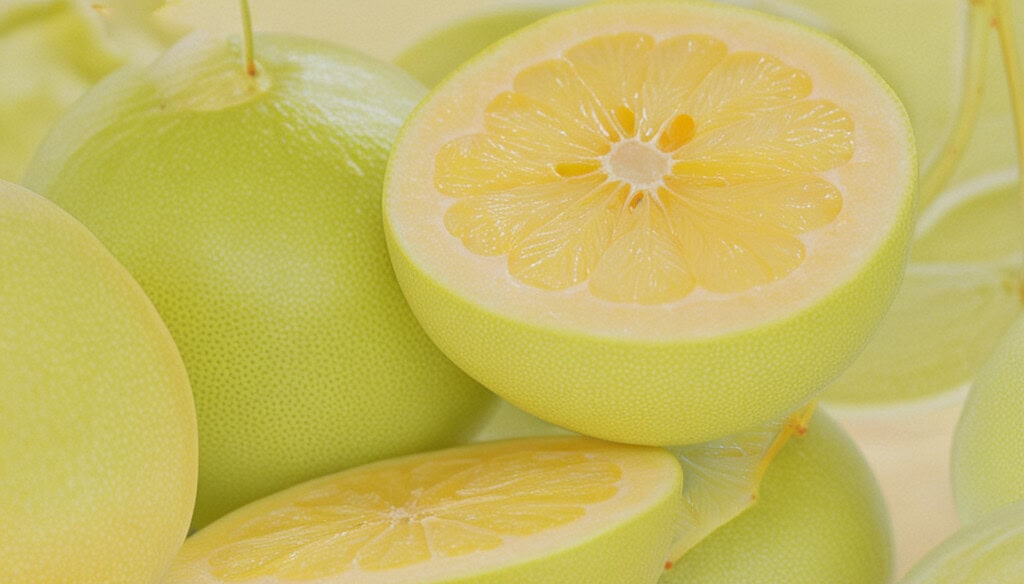Table of Contents
Pomelo: The Giant Citrus Fruit

The pomelo, scientifically known as Citrus maxima, is truly a giant among citrus fruits. It holds the title of being the largest citrus fruit in the world, with some specimens reaching up to 12 inches in diameter and weighing several kilograms. Its size alone is enough to make you stop and take notice, but its significance goes beyond just being big. The pomelo belongs to the Rutaceae family, the same family as its smaller, more commonly known relatives like oranges, lemons, and grapefruits.
What’s fascinating about the pomelo is that it’s one of the ancestors of several other citrus fruits we consume today. Grapefruits, for example, are believed to have been created through a natural hybrid between the pomelo and the sweet orange. This makes the pomelo a bit of a parent to many of the citrus fruits we take for granted.
It’s often described as having a milder, sweeter flavor than a grapefruit, with a thick rind and segmented, juicy flesh that can vary in color from pale yellow to pink. Despite its large size, the pomelo’s sweet, slightly tangy taste is far less sharp than other citrus varieties, making it more approachable for those who aren’t fans of the intense sourness of, say, a lemon.
Beyond its flavor, the pomelo holds deep cultural significance in many parts of the world. In places like Southeast Asia, it’s not just a fruit to enjoy, but also a symbol of prosperity and good fortune. It’s often used in religious ceremonies and rituals, especially during celebrations like the Lunar New Year, where it is presented as an offering to deities. It’s also a common sight at family gatherings and festivals, adding to its status as a fruit of abundance and good health.
Despite its prominent role in many cultures, the pomelo hasn’t been able to achieve the same global recognition as its citrus cousins. Part of this could be due to its size, which can make it impractical for many people who are used to more manageable fruit sizes. But those who do embrace the pomelo appreciate its refreshing qualities, whether eaten fresh, juiced, or even used in cooking.
In the world of citrus fruits, the pomelo stands out as both a historical ancestor and a beloved fruit, offering a taste of sweetness, culture, and a touch of natural grandeur.
Pomelo: A Healthy and Tasty Citrus Fruit With Immense Cultural Significance

The pomelo is much more than just a delicious fruit—it’s a powerhouse of health benefits and carries with it a rich history of cultural significance. Known for its mild, sweet taste, pomelo has a flavor that’s less tart than its citrus cousins, like grapefruit, making it a refreshing treat for anyone looking for something lighter but still packed with zest. People enjoy pomelo in many ways: fresh, as a snack or in salads; juiced, for a citrusy drink; or even as a topping for desserts. Its large size and thick peel might make it seem a bit intimidating at first, but once you get past the rind, its juicy, segmented flesh is incredibly rewarding.
Health-wise, pomelo is an excellent source of vitamin C, which boosts the immune system and helps protect against colds. It’s also packed with antioxidants, which can fight inflammation and reduce the risk of chronic diseases. Pomelo is rich in fiber, which supports healthy digestion and aids in prolonging the sensation of fullness. On top of that, its potassium content helps regulate blood pressure, making it a heart-healthy fruit. For those trying to manage their weight, pomelo’s low-calorie content and hydrating nature make it a great addition to a balanced diet.
But the pomelo’s role doesn’t end with just its health benefits or tasty qualities—it has a significant place in traditional practices and rituals around the world. In Southeast Asia, the pomelo is more than just a fruit to be eaten. It’s often used in ceremonies and festivals, symbolizing abundance, prosperity, and good luck. For instance, during Lunar New Year celebrations in countries like China, Vietnam, and Malaysia, pomelos are offered to deities as a gesture of respect and to invite blessings for the coming year. The fruit’s round shape represents completeness and family unity, making it a perfect offering for such occasions.
In addition to its use in celebrations, pomelo is sometimes part of spiritual and cleansing rituals. Its peel is believed to have purifying properties, and in some cultures, it is used in bathing or incense offerings to ward off negative energy. Whether placed on altars during religious ceremonies or shared among family members during holidays, pomelo has long been a symbol of health, prosperity, and harmony, showing that its value extends far beyond just nutrition or taste.
8 Most Important Cultural and Worshiping Rituals That Use Pomelo

Pomelo Offering During Chhath Puja in India
The pomelo fruit, celebrated for its impressive size and delightful sweet-tangy taste, holds a significant place in various cultural and spiritual traditions worldwide. Its role in numerous rituals extends beyond flavor, embodying deeper meanings such as prosperity, good luck, and reverence for deities and ancestors. Let’s explore some key festivals where the pomelo fruit is prominently featured in vibrant cultural celebrations.
1. Songkan Festival (Thailand)
Songkran, the celebration of the Thai New Year, is characterized by exuberance and a sense of rejuvenation. Taking place from April 13th to 15th, this festival signifies the shift from the dry season to the rainy season. While it is famously recognized for its lively water fights, where participants splash water on each other in the streets, the significance of water goes much deeper. During Songkran, water symbolizes the cleansing of misfortunes, rejuvenation of the spirit, and preparation for the year ahead.
The pomelo fruit plays a vital role in various rituals throughout the festival. On the first day of Songkran, many individuals visit local temples to present offerings to Buddha. Pomelos are often placed on altars alongside other fruits, flowers, and incense, symbolizing abundance and prosperity for the upcoming year. The fruit’s large size and vibrant color make it an attractive offering, representing the fullness and blessings that celebrants wish to receive in the year to come.
Beyond temple offerings, pomelos are also featured in family gatherings. Thai families often create stunning fruit displays that include pomelos, which are shared among family members and guests during New Year meals. This tradition fosters a sense of togetherness and harmony, as everyone comes together to enjoy the blessings of the fruit. The mild sweetness of pomelo is savored fresh or sometimes juiced, adding to the festive atmosphere. Its presence during Songkran serves as a meaningful gesture of gratitude and a source of good fortune for all who participate in the celebration.
2. Chhath Puja (India)
Chhath Puja is a significant Hindu festival mainly observed in Bihar, Jharkhand, Uttar Pradesh, and Nepal. This celebration honors the Sun God, Surya, and Chhathi Maiya who is the daughter of the Creator Lord Brahma. The festivities usually span four days, featuring key rituals that include fasting, making offerings, and performing prayers during sunrise and sunset. It serves as a wonderful occasion for families to unite and express their gratitude to the Sun for its vital energy.
Pomelo, also known as Chakotra in the local language, is widely used during Chhath Puja as an offering to Surya. On the day of the offering, pomelo is placed alongside other fruits like bananas, sugarcane, and coconuts in large bamboo baskets, called thekas. These baskets are carried by devotees as they make their way to rivers or other bodies of water, where they will perform the Arghya (ritual offering of water) to the Sun God. The pomelo’s round shape and bright color symbolize completeness and prosperity, aligning perfectly with the themes of abundance and well-being that the festival represents.
Pomelo’s inclusion in the Chhath Puja offerings is deeply symbolic. Its thick rind and segmented interior represent the protection and stability that the Sun God provides to the world, while its refreshing, sweet taste is seen as a blessing for a fruitful year ahead. During the ritual, the pomelo is presented as part of the larger prasad (blessed food), which is then shared among family and friends as a mark of gratitude and joy.
Apart from the offerings, pomelo plays an important role in family gatherings during Chhath Puja. It is often eaten fresh or used in fruit salads, and its role as a cultural symbol is reinforced by the fact that it is considered auspicious during the festival. The tradition of using pomelo during Chhath Puja continues to be a key element of the celebrations, fostering unity and reverence for the forces of nature that sustain life.
3. Lunar New Year Celebrations (China, Vietnam, Malaysia, Singapore)
Lunar New Year, commonly referred to as Chinese New Year or the Spring Festival, is a major celebration in various East and Southeast Asian nations, such as China, Vietnam, Malaysia, and Singapore. This holiday signifies the beginning of the lunar calendar and serves as a time for families to come together, pay respects to their ancestors, and set intentions for a successful year ahead.
Pomelo holds a special place in these festivities, particularly during Chinese New Year traditions. Many families place this fruit on altars during reunions, making offerings to their ancestors in hopes of receiving their blessings for the upcoming year. The pomelo’s large size and bright color make it a favored choice for these offerings, as it is thought to represent prosperity and abundance. Its round shape symbolizes completeness and family unity, which are central themes of the Lunar New Year.
Beyond being an ancestral offering, pomelo is also enjoyed during festive meals. Its fresh, juicy segments provide a delightful contrast to the richer dishes typically served during the celebrations. In some areas, pomelo is transformed into a special dessert or included in salads, mixed with other fruits and ingredients to create a colorful dish rich in symbolic significance.
In Vietnamese culture, pomelo is particularly significant during Tet, the Vietnamese Lunar New Year. It is frequently used as an offering at family altars to attract good fortune and honor the spirits of the deceased. Similarly, in Malaysia and Singapore, the fruit is regarded as a symbol of prosperity, and its inclusion in festive meals is believed to bring blessings for the year ahead.
The pomelo plays a significant role during the Lunar New Year, symbolizing not only tradition but also the sense of community that comes with the festivities. It is often shared among loved ones, strengthening the connections of love and support that the New Year embodies. The importance of the pomelo in these celebrations is woven into the cultural heritage of these nations, making it a vital element of the holiday season.
4. Qingming Festival (China, Taiwan)
The Qingming Festival, often referred to as Tomb Sweeping Day, is a cherished traditional holiday in China that falls on April 4th or 5th. During this time, families come together to pay tribute to their ancestors by visiting their gravesites, tidying up the tombstones, and presenting offerings. This festival serves as a meaningful occasion to show respect for those who have passed away, ensuring that their spirits are honored and looked after in the afterlife.
Pomelo is often included in the offerings made during Qingming, placed alongside other fruits, tea, incense, and paper money. The fruit’s symbolic value comes from its association with prosperity, good health, and protection, which are all qualities that families hope to offer their ancestors during this solemn day. The bright, inviting color of the pomelo makes it a fitting addition to the altar, representing the vitality of life and the family’s connection to their ancestors.
In addition to being part of the offerings, pomelo is sometimes eaten by families during the festival as a way to reinforce the connection to the living and the dead. It is believed that consuming the fruit can help strengthen family bonds and ensure the well-being of all members. The refreshing taste of pomelo contrasts with the more formal, somber rituals of the day, providing a small moment of joy amidst the respectful remembrance of ancestors.
In Taiwan, the Qingming Festival holds similar significance, with pomelo being used in the same way as in mainland China. It is placed on graves or family altars as part of the ritual offerings, symbolizing the hope for continued family prosperity and harmony. Whether in China or Taiwan, the use of pomelo during Qingming serves as a reminder of the cyclical nature of life and death, and the importance of honoring one’s ancestors.
Pomelo’s role in Qingming is more than just a ritualistic offering; it is a symbol of connection across generations, reinforcing the bonds between the living and the deceased. Through its inclusion in these offerings, the fruit helps maintain the traditions that keep family ties strong, even in the face of death.
5. Bai Sri Su Kwan Ceremony (Laos, Thailand)
The Bai Sri Su Kwan ceremony, a traditional blessing ceremony, is celebrated in both Laos and Thailand. This ceremony is typically performed to bring good fortune, health, and protection to individuals during significant life events such as weddings, housewarmings, or other important milestones. The ritual is a way of welcoming positive energy and ensuring a smooth journey ahead.
Pomelo is often used as part of the offerings in this ceremony, placed on a beautifully arranged altar alongside other symbolic items like flowers, incense, and food. The fruit’s large, rounded shape represents completeness, while its fresh, sweet taste is thought to bring joy and harmony to the participants. During the ceremony, the pomelo is offered to the spirits or ancestors to seek their blessings, and in some cases, it is used as a food offering for the guests who have gathered to join the celebration.
One of the defining aspects of the Bai Sri Su Kwan ceremony is the use of a Bai Sri, a decorative arrangement of flowers, fruits, and other sacred items that are intended to attract positive energy. Pomelo fits perfectly into this display, as its bright color and abundance reflect the themes of fertility, prosperity, and well-being. It is a gift to the spirits, offering not just sustenance but also a wish for good fortune and protection for those involved in the ceremony.
Families and friends gather to participate in the ritual, with the pomelo being shared after the ceremony concludes. The fruit is often enjoyed fresh, sometimes combined with other tropical fruits in a salad. The presence of pomelo in these occasions highlights its role in spiritual rituals and its deep connection to the people who celebrate it.
6. Obon Festival (Japan)
Obon is one of Japan’s most significant festivals, honoring the spirits of ancestors. Held annually in mid-August, Obon is a time when families reunite, visit the graves of their ancestors, and perform rituals to guide the spirits back to their resting places. The festival is deeply rooted in the belief that during Obon, the spirits of the deceased return to the earth to visit their living relatives.
While the use of pomelo is not as widespread as other fruits in Japan, it can occasionally be found as part of the offerings made to ancestors during Obon. During the festival, families prepare an altar known as a butsudan, where they place offerings of food, incense, and flowers to honor their deceased loved ones. In some households, pomelo is added to the offerings due to its symbolic significance of prosperity and abundance. Pomelo’s bright, refreshing appearance is thought to attract positive energy and invite the spirits to return to their homes.
Pomelo is also sometimes included in family meals, served alongside other traditional foods like somen (cold noodles) and obento (boxed meals). The fruit’s mild sweetness and juiciness make it a refreshing addition to the summer meals during Obon, providing both physical and spiritual nourishment. The act of offering food during Obon, including fruits like pomelo, is symbolic of respect and love for the deceased, ensuring they are well cared for even after they’ve passed.
Though not as central to the Obon celebrations as other rituals or foods, pomelo still carries an underlying spiritual importance. The fruit’s role in Obon is a subtle but meaningful part of the festival, reflecting Japan’s deep connection to family, ancestry, and the cycle of life and death.
7. Chung Yeung Festival (Hong Kong, China)
Chung Yeung Festival, commonly referred to as the Double Ninth Festival, takes place on the ninth day of the ninth month in the lunar calendar. This special occasion is dedicated to honoring the elderly, remembering ancestors, and wishing for good health and longevity. A significant tradition during Chung Yeung is tomb sweeping, where families visit their ancestors’ graves to clean the tombstones, present food offerings, and pray for the well-being of their loved ones who have passed away.
Pomelo plays a vital role in these offerings during the festival. Families typically bring this fruit to their ancestors’ graves as a gesture of respect and goodwill. The pomelo, known for its large size and vibrant color, symbolizes abundance and vitality, making it an ideal offering to attract prosperity and good fortune for the family in the upcoming year. Its presence at the grave serves as a reminder of the cycle of life, with the fruit’s refreshing flavor evoking feelings of renewal and continuity.
In addition to being offered at gravesites, pomelo is also used in family celebrations at home during Chung Yeung. The fruit is often included in festive meals and served alongside other symbolic foods such as cakes and tea. The pomelo’s sweetness is appreciated as part of the celebratory atmosphere, and it is often shared with loved ones, reinforcing the idea of family unity and respect for ancestors.
In Hong Kong, the festival is widely celebrated, and pomelo has become a customary fruit for these rituals. In mainland China, the fruit’s use is more common in the southern regions, where families maintain the practice of offering it to ancestors. Regardless of location, the pomelo’s role during Chung Yeung Festival is clear: it is a symbol of good fortune and a way to honor those who came before.
8. Gawai Harvest Festival (Malaysia, Sarawak)
Gawai, the Harvest Festival celebrated by the Dayak people in Sarawak, Malaysia, is one of the most important cultural events of the year. Held on June 1st, Gawai marks the end of the rice harvest and is a time to give thanks for the abundance of the land. It is a festival filled with traditional music, dances, and feasts, where families gather to celebrate their successful harvest and look forward to the future.
Pomelo plays a key role in the Gawai celebrations, especially as part of the offerings made to the spirits. During the festival, Dayak families prepare elaborate displays of food, fruits, and rice in a ritual known as the miring. These offerings are made to honor the spirits of the land and ensure continued prosperity for the next harvest. Pomelo, with its large size and vibrant color, is included in these offerings, symbolizing the hope for a bountiful harvest and a good year ahead.
The fruit is also enjoyed during the Gawai feasts, where it is served fresh or used in fruit salads that accompany the traditional dishes. In some regions, pomelo is even used to make a refreshing juice or added to rice cakes, further enhancing its role in festive meals. Sharing pomelo during Gawai serves as a symbol of community and unity, as people come together to celebrate the fruits of their labor.
Pomelo’s presence at Gawai underscores the importance of agriculture and the relationship between the people and the land. The fruit is a symbol of the harvest’s success and a reminder of the cyclical nature of life. In Sarawak, where the Dayak community lives, Gawai is more than just a festival; it is a way to honor the spiritual connection to the earth and to give thanks for the blessings of the harvest. Pomelo is deeply embedded in these traditions, its role extending beyond being just a fruit to being a symbol of abundance, gratitude, and continuity.
Pomelo: Some Side Effects

Pomelo, cherished for its sweet, tangy flavor and remarkable health benefits, is often celebrated not just as a nutritious fruit but also for its cultural and ritualistic significance. Its large, vibrant appearance and refreshing taste make it a symbol of abundance, prosperity, and good fortune in many traditions. However, like any food, pomelo is not without its limitations. While it offers an array of vitamins and antioxidants, excessive consumption can lead to some undesirable side effects. This is something to consider, whether you’re enjoying it casually or using it in cultural rituals.
One significant concern is Pomelo’s interaction with certain medications. Similar to grapefruit, pomelo contains compounds that can interfere with enzymes responsible for metabolizing specific drugs in the liver. This can result in higher levels of medication in the bloodstream, increasing the risk of adverse effects. Medications such as statins, some blood pressure drugs, and immunosuppressants are particularly affected. If you’re on any of these, it’s wise to consult a healthcare provider before consuming pomelo, even during cultural or ritualistic events.
The fruit’s high vitamin C and fiber content, while beneficial in moderate amounts, can also pose problems if consumed excessively. Too much vitamin C might irritate the stomach, causing symptoms like cramps, diarrhea, or acid reflux. Similarly, excessive fiber from pomelo could lead to digestive discomfort, such as bloating or gas. Those with sensitive digestive systems should be especially cautious and limit their intake.
Pomelo’s natural sugars and acidity also warrant attention. While not overly sugary, consuming large portions of pomelo could lead to spikes in blood sugar, particularly for individuals managing diabetes. The fruit’s acidity, on the other hand, can aggravate acid reflux or heartburn, making it less suitable for people with conditions like GERD.
In cultural and ritualistic settings, where pomelo is often used symbolically or as an offering, it’s important to ensure that its consumption remains balanced. Overindulging, even in a celebratory context, might lead to unnecessary discomfort or health risks. Moderation is key to enjoying pomelo’s health benefits while avoiding potential side effects.
While pomelo is undoubtedly a delightful and culturally rich fruit, a mindful approach to its consumption helps maintain its status as a cherished treat without compromising well-being.
Disclaimers: *This article is only for informational purposes.
**Do not make your important decisions solely based on the information provided in this article. Do your own research.
***Information in this article may vary or get updated in the future.
****Contact a doctor or a medical professional for any medical emergency.
Read More Science and Space Articles
- 8 Culinary Uses of Oranges That I Highly Recommend
- 8 Astounding Ways Lemons Have Helped Elevate My Mood
- 8 Irresistible Ericaceae Fruits (Heath Family) to Savor and Enjoy
- 8 Incredible and Healthy Cucurbitaceae Fruits to Enjoy
- Top 8 Delicious Anacardiaceae Fruits You Must Try
- 8 Incredible Musaceae Fruits You Need to Try Right Now
- 8 Incredible Vitaceae Fruits: Nature’s Tasty Treasures
- 8 Incredible Rosaceae Fruits You Need to Discover
- Discover 8 Fruit Families That Enrich Our Daily Diets
- 8 Non-CO₂ Greenhouse Gasses That Are Worst Than CO₂
- Chemistry: 8 Unique Ways to Become Efficient At It
- 8 Ways Water Crisis is Worsened by Global Climate Change
- 8 Amazing Ways Brain Anatomy is Altered by New Learning
- 8 Disastrous Ways Deforestation Destroys Biodiversity
- Mathematics: 8 Interesting Ways To Become Efficient At It
- 8 Worst Ways Global Climate Change Hurts The Impoverished
- Danger Of Environmental Damage: 8 Ways A Person Can Help
- Eradication Of Poverty: 8 Critical Ways Science Helps
- STEM Fields: 8 Important Reasons Why You Must Learn Them
- Making Your Kid Efficient At STEM Subjects: 8 Important Steps
- Making Your Kid Science Enthusiast: 8 Important Steps
- Becoming A NASA Aspirant: 8 Important Steps You Must Follow
- Top 8 Important Wellness Habits That You Must Follow
- Top 5 Amazing Whole Grains That Are Healthier Than Rice
- Indian Space Program: 8 Incredible Achievements
- Discoveries by JWST: 10 Incredible Findings of The Telescope
- NASA’s MOXIE Creates O2: Big Step Towards Mars Colonization
- Top 5 Amazing Properties of Time That Defy Common Sense
- 10 Factors for Emergence of Intelligent Life in The Universe
- Space Science: 6 Vital Reasons Why We Should Invest in It
- Solar System: 10 Astonishing Uniqueness of our star system
- Top 6 Solar System Objects That Might Destroy Life On Earth
- Certain End of The Universe: 4 Forces of Nature to Watch Out For
- Big Bang: An Incredible Start of Universe 14 Billion Years Ago




